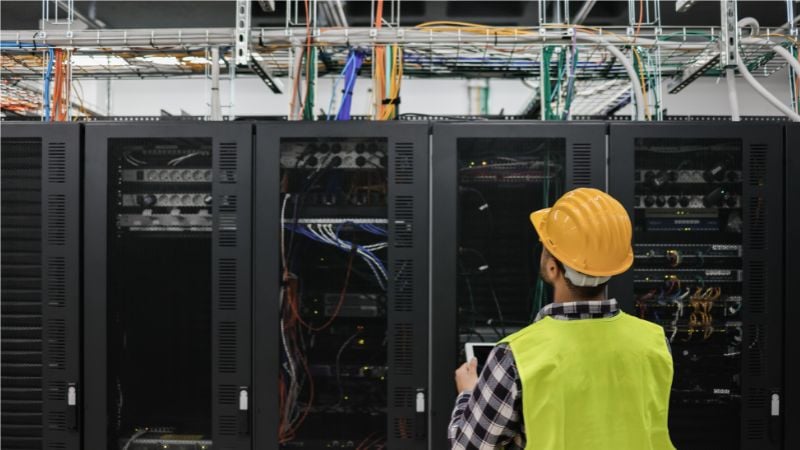User Feedback Shapes OmniOn Power’s Intelligent Distribution Bay
The secondary DC power distribution system provides real-time remote monitoring of networks and circuits.
In large data centers and telecommunication companies, circuit monitoring can increase efficiency and reduce maintenance costs. To address these needs, OmniOn Power’s Intelligent Distribution Bay (IDB) has developed a secondary DC power distribution cabinet capable of remote, real-time monitoring of circuits and networks.
The IDB displays a user’s power-related parameters for the network on the controller’s web-based dashboard. This helps users understand more about their power loads and instances of shutdown.
Data center equipment. Image used courtesy of Adobe Stock
The IDB can remotely monitor up to 160 individual or grouped current loads. Further, the IDB offers power system scalability. Users can arrange flexible configurations of up to eight 800-amp load panels with 20 circuits per panel.
“Now customers can reduce operating and maintenance costs. They can also proactively do predictive maintenance to improve reliability and performance,” Vito Savino, data center and wireline segment leader for OmniOn Power, told EEPower.
How Does the Intelligent Distribution Bay Work?
The IDB takes -48V DC power from a primary source or backup batteries and allows users to subdivide it to support multiple loads. Each load has a unique protective device that monitors circuits in real-time. The intelligent monitoring at the circuit breaker level, instead of at the bay level, means a user starts with only what they need.
Users can then build out their full distribution bay as their needs require. This helps them meet power needs that may change and grow in a “pay as you go” model.
The user can access the data the IDB collects on the distribution bay’s controller and on its associated secure, Internet Protocol (IP)-based web-based, easy-to-read dashboard.
The web-based dashboard and the controller in the bay allow the user to see parameters for every breaker in the bay, including voltage, currents, sizes of breakers, temperatures, and slew rates. The two technologies also provide status updates for items, including on/off status, tripped circuits, breaker ampacity, health status, the number of underload and overload conditions, and breaker serial numbers and manufacture dates.
Intelligent Distribution Bay. Image used courtesy of OmniOn Power
One purpose of the web-based dashboard is to help users determine asset and capacity management to decide whether or not they have room to add equipment. The step eliminates the need to physically visit a site.
Panels in the IDB can be configured in A/B panel pairs or multiple A/B panels for redundant systems. The IDB contains OmniOn’s intelligent Pulsar 100 controller, allowing users to configure individual load alarm thresholds. When users can monitor load performance, they can increase efficiency and manage resources better.
The IDB complements larger DC power systems, including OmniOn’s GPS4848 and GPS4830. The IDB’s configurable cabinets are 7 feet tall by 24 inches deep by 30 inches wide. The compact size makes the bays easy to utilize in medium to large telecom and data center installations.
Creating the Intelligent Distribution Bay
OmniOn Power, a Plano, Texas-based company formerly known as ABB Power Conversion, began developing the IDB in 2022. From user feedback, the team learned operators wanted distribution bays that could offer more than protection. COVID-related supply chain problems slowed the development at first.
“In developing this product, we engaged in a joint effort with a primary circuit breaker supplier. We shared a lot of information so they could understand exactly what we wanted,” said Savino.
OmniOn used a digital twin model to simulate circuit flow and test the IDB before production began to understand what would occur if a certain device failed.
“The U.S. telecom networks require you to make sure a distribution bay can survive a serious earthquake and still operate. We use mechanical modeling tools to simulate the vibrations that would occur,” said Savino.
The work involved putting the 7-foot tall device on a large shaker table and viewing slow-motion videos to ensure the IDB was undamaged and fully functional during and after the tests.
What’s Next for the Intelligent Distribution Bay?
Since the IDB is a game-changer, OmniOn is concentrating on identifying how many people purchase it and how many breakers they add. OmniOn has not yet launched the feature allowing users to reset the breaker remotely.
“Some customers are wary of resetting the breaker remotely because they’re concerned about who might make a mistake. We will look more into that ‘remote on/off’ feature customer by customer. We want to see who expresses interest,” said Savino.
Users in colocation (colo) data centers may be particularly interested in the turn-on feature.
A colo data center is a space a business rents from another party. The data center is not on the renter’s premises. In a colo data center, the “landlord” company offers the infrastructure, like security and cooling. The “renter” business manages components like servers and firewalls.
“A business that rents space in a colo data center typically feeds loads for several of its customers. They will want to know how much current is going to each customer because that is how they bill them,” said Savino.
OmniOn may ask users how they use the information the IDB collects when developing future products.
“With the IDB, a customer will know how many times the device tripped. Each trip causes some end-of-life degradation. The customer also learns the overload conditions that caused the trip. Every incident is a reminder for them to evaluate the equipment downstream from the bay. That’s incredibly valuable information. A customer can replace equipment before failure and avoid downtime,” said Savino.
Savino said the upfront cost of an IDB can be lower than that of a similar device built to capacity when a customer begins using it.
“I expect the cost for a customer’s IDB, once completely filled, to be 25 percent less than that of our current competitors. This device provides a significant return on investment (ROI),” said Savino.








